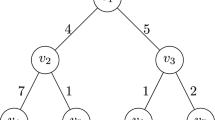Abstract
The exact resolution of large instances of combinatorial optimization problems, such as three dimensional quadratic assignment problem (Q3AP), is a real challenge for grid computing. Indeed, it is necessary to reconsider the resolution algorithms and take into account the characteristics of such environments, especially large scale and dynamic availability of resources, and their multi-domain administration.
In this paper, we revisit the design and implementation of the branch and bound algorithm for solving large combinatorial optimization problems such as Q3AP on the computational grids. Such gridification is based on new ways to efficiently deal with some crucial issues, mainly dynamic adaptive load balancing and fault tolerance. Our new approach allowed the exact resolution on a nation-wide grid of a difficult Q3AP instance. To solve this instance, an average of 1,123 computing cores were used for less than 12 days with a peak of around 3,427 computing cores.






Similar content being viewed by others
References
Aida, K., Futakata, Y.: High-performance parallel and distributed computing for the BMI eigenvalue problem. In: Proceedings of Parallel and Distributed Processing Symposium, IPDPS 2002, pp. 71–78 (2002)
Anstreicher, K., Brixius, N., Goux, J.P., Linderoth, J.: Solving large quadratic assignment problems on computational grids. Math. Program. 91(3), 563–588 (2002)
Bouvry, P., de Kergommeaux, J.C., Trystram, D.: Efficient solutions for mapping parallel programs. In: European Conference on Parallel Processing, pp. 379–390 (1995)
Burkard, R.E., Karisch, S.E., Rendl, F.: QAPLIB—a quadratic assignment problem library. Eur. J. Oper. Res. 55, 115–119 (1991). QAPLIB is found on the web at http://www.seas.upenn.edu/qaplib
Comroe, R., Costello, D.: ARQ schemes for data transmission in mobile radio systems. IEEE J. Sel. Areas Commun. 2(4), 472–481 (1984)
Fedak, G.: XtremWeb: une plate-forme pour l’étude expérimentale du calcul global pair-à-pair. Ph.D. thesis, Université Paris XI (2003)
Foster, I., Kessleman, C., Tuecke, S.: The anatomy of the grid: enabling scalable virtual organizations. Int. J. Supercomput. Appl. 15(3) (2001)
Galea, F., Hahn, P., LeCun, B.: A parallel implementation of the quadratic three-dimensional assignment problem using the Bob++ framework. In: The 21st Conference of the European Chapter on Combinatorial Optimization (2008)
Hahn, P.M., Kim, B.-J., Stutzle, T., Kanthak, S., Hightower, W.L., Ding, Z., Samra, H., Guignard, M.: The quadratic three-dimensional assignment problem: exact and approximate solution methods. Eur. J. Oper. Res. 184, 416–428 (2008)
Iamnitchi, A., Foster, I.: A problem-specific fault-tolerance mechanism for asynchronous, distributed systems. In: 29th International Conference on Parallel Processing (ICPP), Toronto, Canada, August, pp. 21–24 (2000)
Khanli, L.M., Razzaghzadeh, S., Zargari, S.V.: A new step toward load balancing based on competency rank and transitional phases in grid networks. Future Gener. Comput. Syst. 28(4), 682–688 (2012)
Kim, B.-J.: Investigation of methods for solving new classes of quadratic assignment problems (QAPs). Ph.D. thesis, University of Pennsylvania (2006)
Koopmans, T.C., Beckmann, M.J.: Assignment problems and the location of economic activities. Econometrica 25, 53–76 (1957)
Le Cun, B., Roucairol, C.: BOB: a unified platform for implementing branch-and-bound like algorithms. Research report 95/16, PRiSM, Laboratory, University of Versailles, St. Quentin en Yvelines (1995)
Linderoth, J., Margot, F., Thain, G.: Improving bounds on the football pool problem by integer programming and high-throughput computing INFORMS. J. Comput. 21, 445–457 (2009)
Loukil, L., Mehdi, M., Melab, N., Talbi, E., Bouvry, P.: A parallel hybrid genetic algorithm-simulated annealing for solving Q3AP on computational grid. In: Proceedings of IEEE International Symposium on Parallel and Distributed Processing, pp. 1–8, 23–29 May (2009)
Mehdi, M., Melab, N., Talbi, E.-G., Bouvry, P.: Interval-based initialization method for permutation-based problems. In: IEEE Proceedings of World Congress on Computational Intelligence (2010)
Mezmaz, M., Melab, N., Talbi, E.-G.: An efficient load balancing strategy for grid-based branch and bound algorithm. Parallel Comput. 33(4–5), 302–313 (2007)
Samra, H., Ding, Z.: A hybrid ARQ protocol using integrated channel equalization. IEEE Trans. Commun. 53, 1996–2001 (2005)
Sinclair, D.: The GST load balancing algorithm for parallel and distributed systems. Int. J. Approx. Reason. 19(1–2), 39–56 (1998)
Samra, H., Ding, Z., Hahn, P.M.: Optimal symbol mapping diversity for multiple packet transmissions. In: Proceedings of 2003 International Conference on Acoustics, Speech and Signal Processing, Hong Kong (2003)
Zhang, B., Zhang, X., Hu, J., Yang, D.: A hybrid arq scheme with constellation rearrangement and power adjustment. In: Proceedings of the International Conference of Wireless Communications, Networking and Mobile Computing, pp. 464–468 (2005)
Acknowledgements
The present project is supported by the National Research Fund, Luxembourg. Experiments presented in this paper were carried out using the Grid’5000 experimental testbed.
Author information
Authors and Affiliations
Corresponding author
Rights and permissions
About this article
Cite this article
Mezmaz, M., Mehdi, M., Bouvry, P. et al. Solving the three dimensional quadratic assignment problem on a computational grid. Cluster Comput 17, 205–217 (2014). https://doi.org/10.1007/s10586-013-0313-4
Received:
Revised:
Accepted:
Published:
Issue Date:
DOI: https://doi.org/10.1007/s10586-013-0313-4




